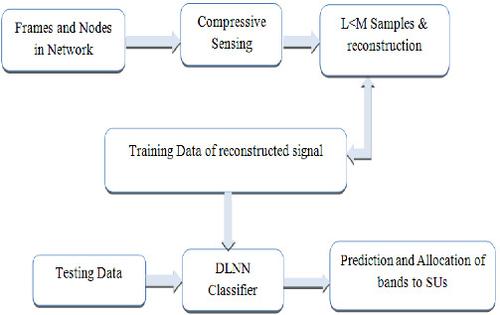当前位置:
X-MOL 学术
›
Int. J. Commun. Syst.
›
论文详情
Our official English website, www.x-mol.net, welcomes your
feedback! (Note: you will need to create a separate account there.)
A hybrid‐supervised learning model for compressive spectrum sensing in fifth generation(5G) cognitive Radio enabled internet of things (IoT) networks
International Journal of Communication Systems ( IF 1.7 ) Pub Date : 2021-04-11 , DOI: 10.1002/dac.4797 Sivasankari Jothiraj 1 , Sridevi Balu 2 , Neelaveni Rangaraj 3
International Journal of Communication Systems ( IF 1.7 ) Pub Date : 2021-04-11 , DOI: 10.1002/dac.4797 Sivasankari Jothiraj 1 , Sridevi Balu 2 , Neelaveni Rangaraj 3
Affiliation

|
5G Internet of Things (IoT) networks are characterized by wideband radio frequency spectrum utility and are therefore of primary importance for efficient means of sensing the wideband spectrum characterized by high bandwidth. A cognitive radio network (CRN) intelligently does the sensing of authorized users ideal spectrum and allocates the same to the demanded unauthorized user. Conventional energy detection and k‐means schemes associated with CRN perform well for narrowband applications, whereas they are not quite suitable for wideband applications. Hence, a compressive collaborative sensing scheme together with deep neural network learning model (CCS‐DLNN) has been proposed to sense the information from the compressed and reconstructed information signal. Based on the extracted features, decision on presence or absence of primary user (PU) in the received signal has been observed. This paper proposes a deep learning neural network model for learning the dynamic change in the input spectra. Accordingly, this paper also updates the weights associated with the neurons to converge upon the target objective. The performance of the proposed sensing scheme has been evaluated pertaining to probability of detection, sensing error, and accuracy of detection of idle channels. The proposed work will be very useful for the upcoming generation departing to be implemented with 5G IoT networks.
中文翻译:

用于第五代(5G)认知无线电的物联网(IoT)网络中压缩频谱感知的混合监督学习模型
5G物联网(IoT)网络的特征在于宽带无线电频谱实用程序,因此对于感测以高带宽为特征的宽带频谱的有效手段至关重要。认知无线电网络(CRN)可以智能地感应授权用户的理想频谱,并将其分配给所需的授权用户。与CRN关联的常规能量检测和k均值方案在窄带应用中表现良好,而它们并不十分适合宽带应用。因此,提出了一种压缩协作感知方案以及深度神经网络学习模型(CCS-DLNN),用于从压缩和重构的信息信号中感知信息。根据提取的特征,已经观察到关于接收信号中是否存在主要用户(PU)的决定。本文提出了一种深度学习神经网络模型,用于学习输入光谱中的动态变化。因此,本文还更新了与神经元相关的权重以收敛于目标目标。已经评估了所提出的感测方案的性能,涉及检测的概率,感测错误和空闲信道的检测准确性。拟议的工作对于即将由5G IoT网络实现的下一代将非常有用。本文还更新了与神经元相关的权重,以收敛于目标目标。已经评估了所提出的感测方案的性能,涉及检测的概率,感测错误和空闲信道的检测准确性。拟议的工作对于即将由5G IoT网络实现的下一代将非常有用。本文还更新了与神经元相关的权重,以收敛于目标目标。已经评估了所提出的感测方案的性能,涉及检测的概率,感测错误和空闲信道的检测准确性。拟议的工作对于即将由5G IoT网络实现的下一代将非常有用。
更新日期:2021-05-04
中文翻译:

用于第五代(5G)认知无线电的物联网(IoT)网络中压缩频谱感知的混合监督学习模型
5G物联网(IoT)网络的特征在于宽带无线电频谱实用程序,因此对于感测以高带宽为特征的宽带频谱的有效手段至关重要。认知无线电网络(CRN)可以智能地感应授权用户的理想频谱,并将其分配给所需的授权用户。与CRN关联的常规能量检测和k均值方案在窄带应用中表现良好,而它们并不十分适合宽带应用。因此,提出了一种压缩协作感知方案以及深度神经网络学习模型(CCS-DLNN),用于从压缩和重构的信息信号中感知信息。根据提取的特征,已经观察到关于接收信号中是否存在主要用户(PU)的决定。本文提出了一种深度学习神经网络模型,用于学习输入光谱中的动态变化。因此,本文还更新了与神经元相关的权重以收敛于目标目标。已经评估了所提出的感测方案的性能,涉及检测的概率,感测错误和空闲信道的检测准确性。拟议的工作对于即将由5G IoT网络实现的下一代将非常有用。本文还更新了与神经元相关的权重,以收敛于目标目标。已经评估了所提出的感测方案的性能,涉及检测的概率,感测错误和空闲信道的检测准确性。拟议的工作对于即将由5G IoT网络实现的下一代将非常有用。本文还更新了与神经元相关的权重,以收敛于目标目标。已经评估了所提出的感测方案的性能,涉及检测的概率,感测错误和空闲信道的检测准确性。拟议的工作对于即将由5G IoT网络实现的下一代将非常有用。











































 京公网安备 11010802027423号
京公网安备 11010802027423号